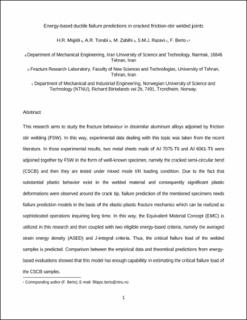| dc.contributor.author | Majidi, Hamid Reza | |
| dc.contributor.author | Torabi, Ali reza | |
| dc.contributor.author | Zabihi, Majed | |
| dc.contributor.author | Razavi, Seyed Mohammad Javad | |
| dc.contributor.author | Berto, Filippo | |
| dc.date.accessioned | 2020-05-15T09:38:00Z | |
| dc.date.available | 2020-05-15T09:38:00Z | |
| dc.date.created | 2019-08-08T11:46:53Z | |
| dc.date.issued | 2019 | |
| dc.identifier.citation | Engineering Failure Analysis. 2019, 102 327-337. | en_US |
| dc.identifier.issn | 1350-6307 | |
| dc.identifier.uri | https://hdl.handle.net/11250/2654613 | |
| dc.description.abstract | This research aims to study the fracture behaviour in dissimilar aluminum alloys adjoined by friction stir welding (FSW). In this way, experimental data dealing with this topic was taken from the recent literature. In those experimental results, two metal sheets made of Al 7075-T6 and Al 6061-T6 were adjoined together by FSW in the form of well-known specimen, namely the cracked semi-circular bend (CSCB) and then they are tested under mixed mode I/II loading condition. Due to the fact that substantial plastic behavior exist in the welded material and consequently significant plastic deformations were observed around the crack tip, failure prediction of the mentioned specimens needs failure prediction models in the basis of the elastic-plastic fracture mechanics which can be realized as sophisticated operations inquiring long time. In this way, the Equivalent Material Concept (EMC) is utilized in this research and then coupled with two eligible energy-based criteria, namely the averaged strain energy density (ASED) and J-integral criteria. Thus, the critical failure load of the welded samples is predicted. Comparison between the empirical data and theoretical predictions from energy-based evaluations showed that this model has enough capability in estimating the critical failure load of the CSCB samples. | en_US |
| dc.language.iso | eng | en_US |
| dc.publisher | Elsevier | en_US |
| dc.rights | Attribution-NonCommercial-NoDerivatives 4.0 Internasjonal | * |
| dc.rights.uri | http://creativecommons.org/licenses/by-nc-nd/4.0/deed.no | * |
| dc.title | Energy-based ductile failure predictions in cracked friction-stir welded joints | en_US |
| dc.type | Peer reviewed | en_US |
| dc.type | Journal article | en_US |
| dc.description.version | acceptedVersion | en_US |
| dc.source.pagenumber | 327-337 | en_US |
| dc.source.volume | 102 | en_US |
| dc.source.journal | Engineering Failure Analysis | en_US |
| dc.identifier.doi | 10.1016/j.engfailanal.2019.04.066 | |
| dc.identifier.cristin | 1714805 | |
| dc.description.localcode | © 2019. This is the authors’ accepted and refereed manuscript to the article. Locked until 26.4.2021 due to copyright restrictions. This manuscript version is made available under the CC-BY-NC-ND 4.0 license http://creativecommons.org/licenses/by-nc-nd/4.0/ " | en_US |
| cristin.unitcode | 194,64,92,0 | |
| cristin.unitname | Institutt for maskinteknikk og produksjon | |
| cristin.ispublished | true | |
| cristin.fulltext | preprint | |
| cristin.qualitycode | 1 | |

